Representation of the ipsilateral visual field by neurons in the macaque lateral intraparietal cortex depends on the forebrain commissures
- PMID: 20660427
- PMCID: PMC2997031
- DOI: 10.1152/jn.00752.2009
Representation of the ipsilateral visual field by neurons in the macaque lateral intraparietal cortex depends on the forebrain commissures
Abstract
Our eyes are constantly moving, allowing us to attend to different visual objects in the environment. With each eye movement, a given object activates an entirely new set of visual neurons, yet we perceive a stable scene. One neural mechanism that may contribute to visual stability is remapping. Neurons in several brain regions respond to visual stimuli presented outside the receptive field when an eye movement brings the stimulated location into the receptive field. The stored representation of a visual stimulus is remapped, or updated, in conjunction with the saccade. Remapping depends on neurons being able to receive visual information from outside the classic receptive field. In previous studies, we asked whether remapping across hemifields depends on the forebrain commissures. We found that, when the forebrain commissures are transected, behavior dependent on accurate spatial updating is initially impaired but recovers over time. Moreover, neurons in lateral intraparietal cortex (LIP) continue to remap information across hemifields in the absence of the forebrain commissures. One possible explanation for the preserved across-hemifield remapping in split-brain animals is that neurons in a single hemisphere could represent visual information from both visual fields. In the present study, we measured receptive fields of LIP neurons in split-brain monkeys and compared them with receptive fields in intact monkeys. We found a small number of neurons with bilateral receptive fields in the intact monkeys. In contrast, we found no such neurons in the split-brain animals. We conclude that bilateral representations in area LIP following forebrain commissures transection cannot account for remapping across hemifields.
Figures
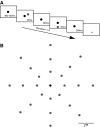
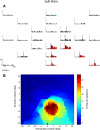


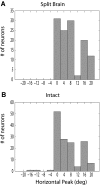
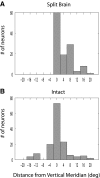
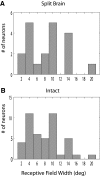

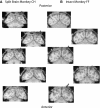
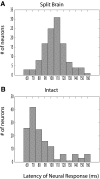
References
-
- Andersen RA, Asanuma C, Essick G, Siegel RM. Corticocortical connections of anatomically and physiologically defined subdivisions within the inferior parietal lobule. J Comp Neurol 296: 65–113, 1990 - PubMed
-
- Antonetty CM, Webster KE. The organisation of the spinotectal projection. An experimental study in the rat. J Comp Neurol 163: 449–465, 1975 - PubMed
-
- Barash S, Bracewell RM, Fogassi L, Gnadt JW, Andersen RA. Saccade-related activity in the lateral intraparietal area. II. Spatial properties. J Neurophysiol 66: 1109–1124, 1991 - PubMed
-
- Basso MA, Liu P. Context-dependent effects of substantia nigra stimulation on eye movements. J Neurophysiol 97: 4129–4142, 2007 - PubMed
-
- Basso MA, Pokorny JJ, Liu P. Activity of substantia nigra pars reticulata neurons during smooth pursuit eye movements in monkeys. Eur J Neurosci 22: 448–464, 2005 - PubMed
Publication types
MeSH terms
Grants and funding
LinkOut - more resources
Full Text Sources

